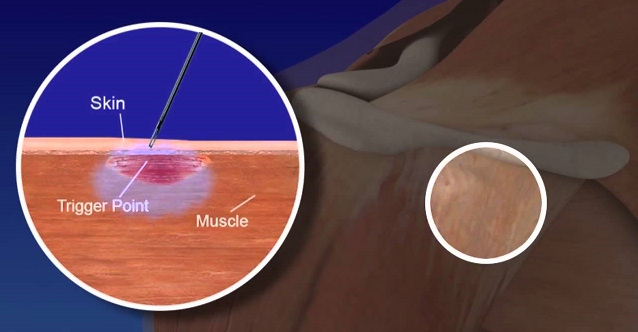
At the Center for Pain Relief, we treat patients with compassion and respect as we help them manage their pain. Located at the Medical Office Building at Pine Creek Medical Center in Dallas, our center primarily focuses on interventional pain management but also incorporates medical pain management.
[/vc_cta]
Trigger Point Injections
Trigger point injections are a type of local injection that your physician can use to treat local areas of muscle pain and spasm. Applying firm pressure to these muscle areas cause localized pain and at times referred pain that can mimic the pain coming from “pinched nerves” in the neck and the lower back. Your physician may choose to give a trial of trigger point injections to see if they can help relieve pain to these areas of muscle pain.
Medications utilized with the trigger point injections may consist of a combination of saline, local anesthetic and steroids. If the injection is effective, and predictably so, but short lived, then Botulinum Toxin A might be indicated to achieve a longer lasting pain relief.
What are Trigger Points?
Trigger points are tight knots that form in your muscles and tissues as a result of muscle injury or repetitive strain from sporting activities and/or continued muscle overuse. When stressed or injured, muscles often form trigger point “knots” that cause pain and tightness. Myofascial (“myo” for muscle, “facial” for tissue) trigger points are hypersensitive areas in the tissue surrounding skeletal muscle. These trigger points may soon be accompanied by chronic myofascial pain.
What is a Trigger Point Injection?
A trigger point injection is a direct delivery of a corticosteroid medication into a trigger point on the body to reduce or eliminate discomfort.
These injections can also be used to help reduce pain for other conditions such as fibromyalgia and tension headaches.
How is the Trigger Point Injection Performed?
A small needle is inserted into the trigger point which often delivers two things: A local anesthetic to numb the area and a corticosteroid to administer pain relief.
After the procedure, the injection area will be numb for 1 to 3 hours while the corticosteroids remain active in the tissue for 1 month.
Several trigger points injections can be performed on the same visit without cause for concern. The procedure is usually very quick and the patient may go home shortly after the injections are completed.
Are the Trigger Point Injections Successful?
Trigger point injections do have a high success rate, but each patient may react differently to the procedure. While instantaneous pain relief may be achieved, it can typically take 24-48 hours for full complete pain management.
Further, if the pain persists, the patient may receive subsequent trigger point injections at a later date due to this being a repeatable procedure.
Trigger Point Injection Risks
As with most injections, the patient may develop bruises, swelling or soreness at the site of the procedure. These side effects usually disappear on their own soon after the office visit, and are superficial in nature. It is very rare to have permanent side effects from a trigger point injection aside from enjoying a reduction in pain.
When injections are used there is a slight chance of:
- Nerve Injury – When a needle is inserted into the muscle or tissue, there is a slight possibility of nerve injury.
- Bleeding – If the needle penetrates a vein or capillary bleeding may occur.
- Infection – Due to an injection being an invasive procedure, infection can occur.



